The iPhone 4 Redux: Analyzing Apple's iOS 4.0.1 Signal Fix & Antenna Issue
by Brian Klug & Anand Lal Shimpi on July 15, 2010 12:28 PM EST- Posted in
- Smartphones
- Apple
- iOS 4
- iPhone 4
- Mobile
In case you haven’t noticed, the iPhone 4’s antenna design has come under considerable scrutiny. In our iPhone 4 review, we investigated the iPhone 4 antenna and came to two conclusions. First, that iOS 4 was displaying signal bars in an overly optimistic manner, compressing the dynamic range of possible signal bars users can see. Second, we identified a worst case signal drop of around 24 dB when the iPhone 4 is cupped tightly in the left hand, covering the black strip and possibly detuning the antennas and adding additional attenuation from the presence of the hand.
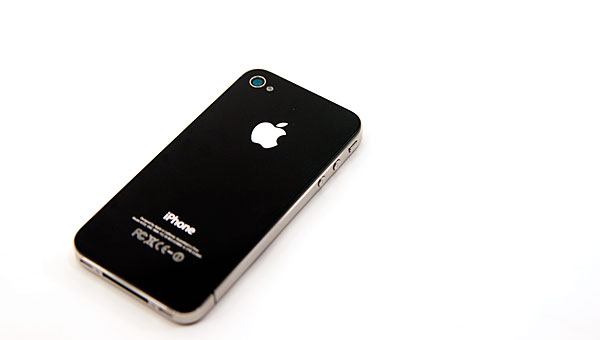
Since those initial measurements, we’ve been working tirelessly to both characterize the problem, fully understand the mechanisms behind it, and report on a number of possible solutions.
The Bars Have Changed
On July 2, Apple released a letter noting that the formula used in iOS 4.0 to calculate how many bars are presented for each signal strength is “totally wrong.” This mirrored our conclusions that the effects of the signal drop were exacerbated in part by the way the iPhone visualizes signal strength - the dynamic range is compressed so much that the 24 dB drop from cupping the phone without a case could make all the bars go away.
They went on to promise that in a future software update they would make bars 1, 2, and 3 taller, and make the bars more “accurate” by displaying 2 bars fewer in certain circumstances.
iOS 4.1 beta rolled around yesterday, and we immediately dove in to find out just how much the bar to signal strength mapping has changed. Update: iOS 4.0.1 final just came out this afternoon and we finished preliminary testing. The signal strength mapping algorithms are identical to the 4.1 beta. The findings in this article apply to 4.0.1 as well as the 4.1 beta.

After updating our devices to the iOS 4.1 beta (and 4.0.1) and making sure our little trick to show signal strength in dBm instead of bars still worked, we set off. Remember last time how I said I drove around town all day with iOS 4.0, testing the phone, and recording signal strength and how many bars were being shown? You guessed it - another update, another evening of driving around. Anand and I did quite our fair share of moving around to get a complete picture of what the new cutoffs are.
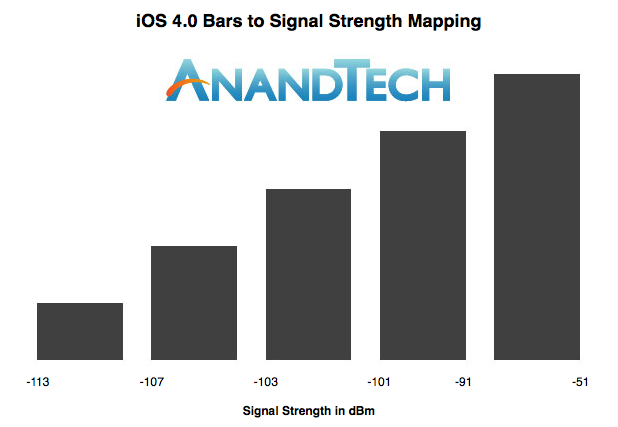
Old Bars
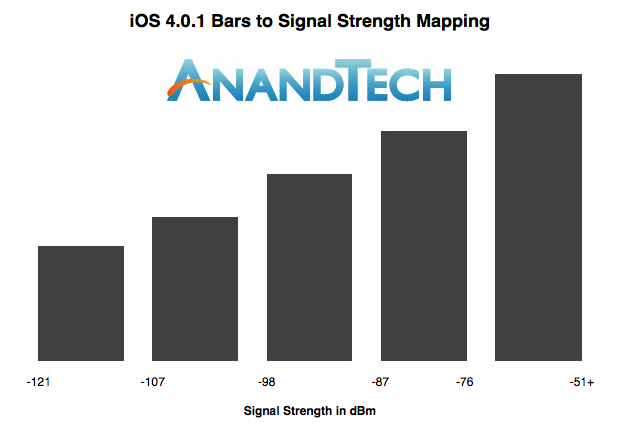
New Bars
The results are conclusive - Apple has dramatically changed the signal strength to signal bar mapping in iOS 4.0.1 and the iOS 4.1 beta, making the dynamic range not only much broader, but the range values for each bar much wider. The range of signals that correspond to bars three and four are the same width, and bar two is only slightly less.
The cutoff value for two bars to one bar remains the same, but every other value has increased. The result is that the worst case drop of 24 dBm no longer makes all the signal bars disappear, but rather two.
AnandTech reader Mike Escoffery, Director of Design and User Experience at Media Platforms, created his own diagram to help compare the old and new way of iOS signal strength reporting:
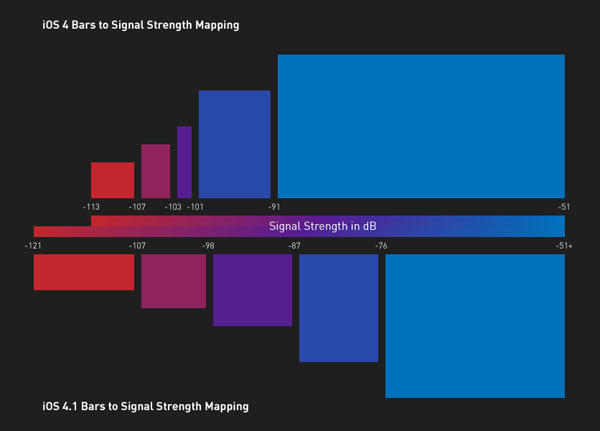
As you can see the old way (top) put far too much weight into the 5th bar of signal. Apple's new approach not only splits it up more reasonably between the 4th and 5th bar (still non-linearly keeping you in the 5th bar if possible) but also extends the range of the lower bars.
This change actually presented itself in our numeric signal strength reports - there’s more dynamic range in these numbers too. Previously, the absolute lowest value any iPhone would report was -113 dBm. With iOS 4.0.1/4.1, the value is now a shockingly low -121 dBm. In the iPhone 4 review, I talked a lot about how although the phone is prone to dropping signal from being held wrong, it was measurably more sensitive in weak signal areas. I was shocked that calls and data worked seemingly unfazed at -113 dBm. It seems as though this increased 8 dBm of range below -113 dBm was meant to show really how much more sensitive the radio stack is - it undeniably is more sensitive. Both Anand and I were able to hang onto calls all the way down at -121 dBm.
We’ve also included a comparison to how the latest version of Android displays signal bars from GSM or UMTS networks below. Thankfully, this didn’t require driving around town all day but rather inspecting the latest version of the Android source code from Google’s own repositories. Android uses an ASU value to compute signal strength, which isn’t anything more than a remapping of dBm to a sane value that’s a bit easier to interpret.
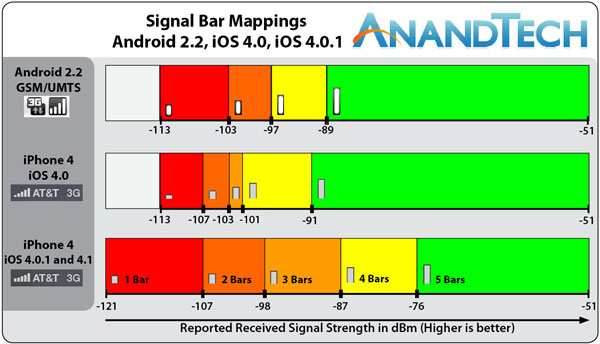
Apple’s mappings have gone from having probably the most compressed dynamic range among handset vendors to less compressed than Android.
While the software update obviously does not and cannot address the design of the antenna itself - or make the drop from holding the phone any less - it does change the way the issue is perceived among users. The result is that most iPhone users will see fewer bars disappear when they hold the iPhone 4 in a bare hand. The side effect is that the iPhone now displays fewer bars in most places, and users that haven’t been reporting signal in dBm will time see the - perhaps a bit shocking - reality of locations previously denoted as having excellent signal.
Interestingly enough, Apple has indeed changed the heights of bars 1, 2, and 3. They’re taller, and the result is that the relative heights are no longer linear, but rather a tad exponential looking. It’s a mind trick that Apple no doubt hopes will make the signal look better. If the bars are taller, they must denote stronger signal, right?
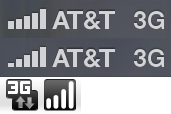
From top to bottom: iOS 4.1, iOS 4.0, Android 2.2
The reality is that Apple likely wants to deflect at least some of the initial backlash AT&T will face for reporting the signal bars without any concessions. Concessions that used to make coverage look better than it really is. Regardless of how tall the bars are, there are still going to be fewer of them virtually everywhere. Interestingly enough, while bars 1 and 2 are the most changed, their respective cutoffs are virtually unchanged.
While I was testing iOS 4.0.1, I told Anand that the signal reporting lie that started with the iPhone 3G had been removed entirely. That iOS 4.0.1 would potentially show the reality of AT&T’s coverage to iPhone users. With 4.0.1 users looking at signal bars will get a much more realistic view of how signal is changing.
We tested the iOS 4.1 beta on iPhone 3GSes as well, and found the mappings to be the same there as well.










146 Comments
View All Comments
takkischitt - Thursday, July 22, 2010 - link
Hi,I've been looking everywhere to try and source the correct Kapton tape but I'm struggling.
Can anyone give me an extact model number and description so I can hopefully find the right one to order on the net?
Thanks!
Great article btw
crashnburn - Saturday, July 24, 2010 - link
Question is.. Am I better off with getting an iPhone 4 or a 3GSv12v12 - Sunday, July 25, 2010 - link
Wow this is hilarious... people are using tape and all kinds of MacGyver tricks and tinkering to get it to work "properly" or "better." WHO DOES THIS? Would any of you accept a washing machine that required a rubber stopper from home depot to properly seal in water? Or would you use some aluminum foil to increase your brand new flat screen's picture (hypothetically speaking of course)???RETURN the fscking thing, roll the dice and get another one, OR get a Droid or some other phone thats known to work?
The stupid masses have gotten HAD again... "OMG I've GOT to get the newest, (BETA) latest, greatest phone so I can be cool and waste hours of daily productivity playing around with it like a toy like everyone else..." Baaaaah baaaaaaah, said the sheeple. WAKE UP noobs, YOU DO NOT BUY NEW PHONES, until they've been thoroughly tested and de-bugged. Christ, anyone that knows anything about technology knows TODAYS devices are public-BETAs that the corps use YOU to test, while they profit from your fully-paid dollars up front, which they immediately invest in hedge funds and the stock market to recoop massive short-sell interest from, while YOU all are not only footing the bill for, BUT doing all the leg-work by testing the phones and reporting (complaining) back to them... I digress.
YOU all are the problem, there's NEVER been a "beta-test" type market like this crap we have today, bc YOU all have ALLOWED this POS beta-warez business model to flourish and take advantage OF US ALL... This is just a waste of txt, since you'll just keep buying and shopping to be "cool," and "hip."
Thanks a lot sheep... See you at the slaughter house! Please... AFTER YOU... I insist ;-)
kalleboo - Tuesday, July 27, 2010 - link
The android bars vary by manufacturer, they're not all exactly the same. My Sony Ericsson X10 shows 3 bars for -85 dBm/14 asu, contrary to this graphbubblesmoney - Wednesday, July 28, 2010 - link
On GSM or UMTS frequencies (between 870 MHz to 2170MHz around the world) used the noise signal floor is between -111 to -114dbm. The signal noise floor is that strength at which the signal cannot be distinguished from background radiation.The signal noise floor depends on the frequency of broadcast and not the device as far as i am aware. So the iphone cannot have a different noise floor compared to other mobile phones, unless Jobs got the governments all over the world to beam a special signal on a different frequency purely for the iphones!!!!
Anandtech has made a basic error in this analysis i think and consequently this whole article is wrong and meant to favour the iphone either inadvertantly or deliberately.
see post number 57 on the thread in this link for my explanation why this anandtech article is wrong http://forums.moneysavingexpert.com/showthread.php...
please note that -113dbm (some resources say -111 instead of -113) is the noise floor where signal is indistinguishible from background radiation. look it up in science webpages if you doubt what i say. so if the iphone shows signal to be -120dbm then that is an error. just because it shows a number does not mean that the -113 noise floor value does not exist in physics for gsm broadcast frequencies. http://en.wikipedia.org/wiki/Johnson%E2%80%93Nyqui...
see gsm freq bands for the world here http://en.wikipedia.org/wiki/GSM_frequency_bands the freq bands (GSM AND UMTS) used in uk are between 870 to 2170MHz and for that the noise floor is between -111dbm and -113dbm and for the noise floor to be 120dbm the freq would have to be in 180kilohertz which is !!!! and bull as the freq bands used are in MHz so the anandtech numbers dont add up in the 120dbm small print, as there is no 180kilohtz band for gsm in usa or uk as far as i can tell!!!! and 180khz is the freq used for AM band radio and looks like the iphone4 is getting interference from 180khz AM band radio signals too as far i can tell from what anandtech says about 120dbm etc !!! yikes!
I would be happy to be proved wrong and to learn, but from what i have shown i am right! Noise floor depends on the frequency band of transmission rather than circuitry. In the UK Cellular mobile services operate within the frequency ranges 872-960 MHz, 1710-1875 MHz and 1920 - 2170 MHz so the noise floor would be between -114 to -111dbm.
It would be similar in the USA too.
see the rest of my detailed response elsewhere on other forums (post 57 of the thread on the link) http://forums.moneysavingexpert.com/showthread.php...
I hope there is a response to this comment of mine, from this articles writers or some other RF engineers, as due to the reasons quoted in my ananlysis i think this article by anandtech is grossly wrong. I would be happy to stand corrected if my analysis is wrong.
yes the signals can be sensed at -120dbm but that wouldnt be signals from commercial GSM or UMTS signals, it would be some other signals sensed by the iphone4 sensors and giving a wrong reading of the signal strength. As i said earlier the signal noise floor depends on the broadcast frequency and not the handset, so this article is wrong and grossly so as it is making assumptions of the iphone4 being able to sense GSM / UMTS signals of the order of 120dbm which isnt possible for the frequencies broadcast as per the physics involved. http://en.wikipedia.org/wiki/Johnson%E2%80%93Nyqui... that or Jobs and anandtech found some way to defy physics!
amariofrmdamoon - Sunday, November 4, 2012 - link
I've never seen kapton tape used that way, but a good source for it seems to be www.kaptontape.com. There are some other insulating tapes at www.maskingproducts.net. May be worth a try to see if some other cheaper tapes work in a similar manner. Anyone know if it works similarly with the iphone 5. Thanks!